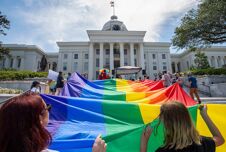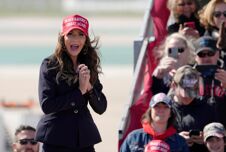The Walt Disney Company has a complex relationship and history with the LGBTQ+ community, from flip-flopping on Florida’s Don’t Say Gay bill to hosting Gay Days at the parks to censoring queer stories from Pixar films.
But the queer Easter eggs in the movies are another story. These tidbits are the facts that you might not have known about the queer history of the House of Mouse.
Related:
Rumor has it Disney cut a scene from “The Marvels” pointing to a lesbian romance
Fans have been begging for a romance between Captain Marvel and Valkyrie for years.
1. The infamous villains and musclemen of the cartoon classics were animated by a gay man
Never Miss a Beat
Subscribe to our newsletter to stay ahead of the latest LGBTQ+ political news and insights.
The Polish-born Disney animator Andreas Deja, who was the supervising animator for some of the most infamous Disney villains, is openly gay. He took the lead on animation for Gaston in Beauty and the Beast, Jafar in Aladdin, Scar in The Lion King, Hercules in Hercules, King Triton in The Little Mermaid, Lilo in Lilo & Stitch, and others.
Disney villains like Scar and Jafar are infamously queer-coded with characteristics like a limp wrist and fabulously arched eyebrows. Some say this correlated queerness with evil is a problematic practice, though others say the representation — no matter how dubious — gave some kind of visibility on screen for LGBTQ+ people. Knowing that a gay man animated some of these camp icons adds a wrinkle to this debate.
Besides the characters animated by Deja, King Candy (Wreck-It Ralph), Governor Radcliffe and his assistant Wiggins (Pocahontas), and Captain Hook (Peter Pan) are some classically queer-coded Disney villains.
2. Two of the Madrigal sisters were voiced by out queer actresses
Mirabel and Luisa Madrigal in Encanto are voiced by out queer women. When asked at the 2022 Oscars about Disney’s lack of opposition to the “Don’t Say Gay” law in Florida, Luisa’s voice actress Jessica Darrow said, “Here I am being queer and gorgeous and I’m on the red carpet and I’m very happy to represent fellow gorgeous queer people that consume Disney. We are all here. We are the face of Disney at the end of the day.”
Stephanie Beatriz voices protagonist Mirabel and she is proudly bisexual. In a 2018 essay in GQ, Beatriz wrote, “I’ll be bi till the day I die, baby, and I vow to myself to always sing that truth.”
3. Loki’s gender fluidity is canon
In the Disney+ show Loki, viewers see a file on the character that reads “Sex: Fluid” along with other facts like height and eye color. Director Kate Herron confirmed that the character Loki is “gender-fluid in the Norse mythology and the comics and it felt like an important thing to […] make sure it’s canon.”
Actor Tom Hiddleston, who plays Loki, said, “It’s always been there in the mythology. It’s been in the comics as long as, I think, the run of publishing within Marvel, over 60-plus years. Loki, as a character, has had such a broad and wide-ranging identity. He’s always been a character that you could never put in a box, that you could never pin down, and I was really pleased that we were able to touch on that in the series.”
4. Lady and the Tramp were basically lesbians
Well, the two animated dogs were based on two female dogs. The 1955 film was inspired by real-life dogs. Walt Disney brought his wife a Cocker Spaniel puppy as a gift in a hat box in 1925, just like Lady was presented by Jim Dear. Years later, the model for Lady was an animator’s Cocker Spaniel named Blondie. A Disney storyman spotted a shaggy stray dog in the bushes and tracked it down at the pound. The dog was a young female and became the live model for Tramp, living out her life adopted by a Hollywood family.
5. “Mickey Mouse” was code for homosexuality in the 1930s
In the book Tinker Belles and Evil Queens: The Walt Disney Company from the Inside Out, Sean P. Griffin writes that a group of lesbians in Chicago threw parties in the 1930s called “Mickey Mouse parties” and that there was a gay bar in Berlin called “Mickey Mouse.”
Griffin explains that this time period is when the word “gay” was starting to be used as slang for homosexuality instead of just meaning happiness. There was a poster of Mickey that said “Always Gay!” on it and Griffin writes, “Although Walt and most (if not all) of his employees probably would not have known this new meaning to the word when they created the aforementioned poster in the 1930s, it seems that certain audience members were watching and enjoying Mickey’s ‘gaiety’ in all its connotations. This dynamic becomes more apparent when certain historical evidence suggests that the phrase ‘Mickey Mouse’ itself was bandied about by some homosexuals as a code phrase.”
6. Queer movie characters pop up often (usually far in the background) and have caused movies to be banned in several countries
- Beauty and the Beast (2017): LeFou was marketed as openly gay in the live-action version of this movie, though he wasn’t overtly queer in the original animated classic. But Josh Gad, who played the character, agreed with queer fans that the representation did not go far enough. LeFou only had one scene of dancing with another man and hardly any other clues to his orientation.
- Elemental (2023): Lake Ripple, younger sibling of Wade Ripple, is Disney’s first officially nonbinary character. They’re voiced by nonbinary voice actor Kai Ava Hauser.
- Eternals (2021): Phastos (Brian Tyree Henry) has a husband and son and is billed as the first openly queer character in the Marvel Cinematic Universe.
- Frozen (2013): Oaken of Oaken’s Trading Post (“Yoo hoo! Big summer blowout!”) shows his family in the sauna and the largest family member in the middle, presumably Oaken’s partner, is a man.
- Lightyear (2022): Alicia Hawthorne, Buzz Lightyear’s mentor and best friend, was an openly queer character that made media headlines for having a same-sex kiss in the movie. She was a more significant character than a small sidekick role and the movie shows her with a female partner and their child. She’s voiced by openly queer actress Uzo Aduba. As a result of her character’s visibility in the movie, Lightyear was banned in 14 countries.
- Onward (2020): Officer Specter is a cyclops police officer who mentions her girlfriend. She is voiced by out actor Lena Waithe.
- Star Wars: The Rise of Skywalker (2019): Commander Larma D’Acy (Amanda Lawrence) kisses her pilot wife Wrobie Tyce (Vinette Robinson) at the end of the movie in a blink-and-you’ll-miss-it moment.
- Strange World (2022): Ethan Clade is Disney’s first true openly queer protagonist. He is voiced by openly queer Jaboukie Young-White. Strange World had no theatrical release in 20 countries across Asia and Africa.
- Zootopia (2016): Judy Hopp’s neighbors are two male antelopes who share the last name Oryx-Antlerson.
Besides these movie characters, Disney-owned TV shows like Owl House have taken more liberty with openly LGBTQ+ characters. The Marvel comics are also full of LGBTQ+ representation.
7. It’s been confirmed that Ursula was based on the drag queen Divine
Disney composer Alan Menken confirmed this year that Divine (1945-1988), a Baltimore drag queen who starred in the 1972 movie Pink Flamingos by gay icon John Waters, was Disney’s inspiration for The Little Mermaid’s Ursula.
“Ursula was an outsider. She was magic. She had a style that some people might not understand,” Waters said. “But she was proud of herself. She was confident. She never questioned her look. She never felt — as other people might have — that she looked weird or anything. She looked beautiful on her own terms.”
Melissa McCarthy, who played Ursula in the 2023 live-action remake, said that she watched the animated classic every night as a nanny: “I always was like, I know for a fact — but I couldn’t prove it — that she had to be based on Divine. She just had to be. I was like, ‘the makeup, the look, the attitude.’ And now we know that yes, she was of course based on Divine.”
8. A gay man “gave a mermaid her voice and a beast his soul.”
Howard Ashman (1950–1991) died of complications from AIDS at the age of 40 before he was able to see the song he wrote the lyrics for – Beauty and the Beast from the movie of the same name – win an Academy Award for Best Original Song in 1991. Ashman’s partner accepted the award saying to the crowd, “Howard and I shared a home and a life together, and I’m very happy and very proud to accept this for him, but it is bittersweet. This is the first Academy Award given to someone we’ve lost to AIDS.”
Ashman started working at Walt Disney Studios in 1986 and won an Oscar for writing “Under the Sea” for The Little Mermaid in 1989. He also earned a nomination for “Kiss the Girl.” He was the one who pitched the idea for Aladdin and was nominated for another posthumous Academy award in 1992 for “Friend Like Me.” (He also wrote “Arabian Nights” and “Prince Ali.”)
At the end credits of Beauty and the Beast, for which he wrote all of the lyrics, the dedication reads: “To our friend Howard, who gave a mermaid her voice, and a beast his soul. We will be forever grateful.”

















